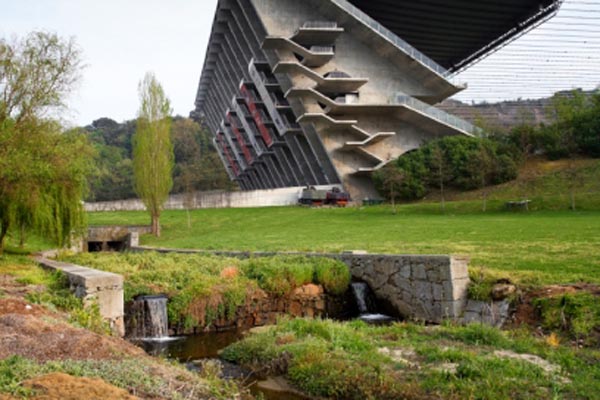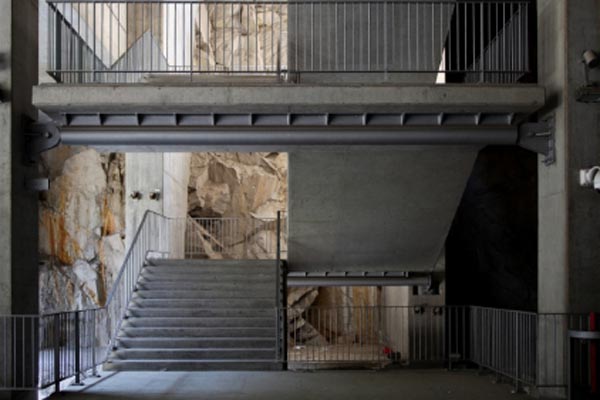Building Stories
"Even uninteresting reality may seem to be a deliberate choice when framed convincingly. Isn't it true that the greatest misery, waste, and war can generate wonderful photos?" —Eduardo Souto de Moura
What makes some slices of reality more interesting than others? Can reality even be split up by choice? What does it mean to frame something "convincingly"? Is it true that the greatest misery, waste, and war can generate wonderful photos? And if so, what exactly does "wonderful" mean there? These aren't rhetorical questions. They're very real concerns of the sort that Eduardo Souto de Moura, the 2011 Pritzker Prize winner, casually raises throughout his running commentary in Thom Andersen's latest film, Reconversão, a study of 17 of the architect's projects. As with Andersen's own annotations in Los Angeles Plays Itself, Souto de Moura's thoughts (as well as Andersen's snippets of contextualization) are delivered by Encke King, whose singular voice, with its disaffected clarity and garnish of wry humor, acts once again as a kind of distancing device, a reminder that these words are but one specific set out of many possible perspectives on the material under examination. This democratic spirit can be found at the heart of all of Andersen's work, in which a known quantity—Eadward Muybridge (Eadward Muybridge, Zoopraxographer), a number of classic films of the McCarthy era (Red Hollywood), Los Angeles in the movies (Los Angeles Plays Itself), the ubiquitous signage of Southern California (Get Out of the Car)—is exploded via an idiosyncratic reading that filters a wide array of thinkers and ideas through Andersen's own slippery, attentive critical temperament; he's the closest thing we have today to Manny Farber.

Reconversão
As much as Andersen's unmistakable perspective unites his entire body of work, Reconversão links seamlessly as a follow-up to Get Out of the Car, Souto de Moura's obsession with the ruin as an architectural figure presenting a somewhat more positive iteration of that film's catalog of material and cultural decay around Los Angeles. Across the 17 projects that Andersen examines—several of the more ambitious designs having never been taken to construction—the idea of the ruin returns time and again, its role and meaning in a perpetual state of flux. "Reconversion of a Ruin," the earliest of Souto de Moura's solo projects shown in the film, saw the architect attempt to convert an abandoned barn into a livable space without changing its fundamental state of disrepair; the only additions were a new door, one glass wall, and a roof—the project was never completed beyond these changes. In effect, the project existed only as a brief discursion away from the building's trajectory as an object in, and of, the natural world: the essence of Souto de Moura's approach lies in this understanding of the ruin as the material point of contact between architecture and nature.
This ebb and flow of the architectural and the natural plays out even more clearly in Souta de Moura's 30-year engagement with Braga's Mercado Cultural do Carandá. Originally commissioned in 1980 as a closed market built within the space between a pair of paths connecting housing sites, the project eventually became obsolete when its very presence came to serve as the locus for further commercial construction in the area—it was rendered useless as a market by the schools, housing, and stores erected all around it. Souto de Moura was granted permission in 1999 by the town to convert the market into a garden, which he did by creating an artificially accelerated ruin, removing the roof and walls and leaving only the original design's columns standing, reinforcement wires erupting from their ragged tops like flames. The remaining space surrounding the old market was filled in with shops on one side and a dance school on the other, completing the process by which the market was effectively flipped inside out. (A music school was added a decade later, further enclosing the space and, fittingly, leading to it once again becoming a market for local vendors.)

Reconversão
Elsewhere, a home is built into a hillside, a monastery becomes a luxury hotel, and a centuries-old waterworks is found during excavation for a state of the art metro system, and left in place. In each project, Souto de Moura seems to implicitly ask what the bare minimum of alternations are that can be made to a natural environment—whether it's a hillside or a delapidated building—in order for it to function as a space for living. The resulting spaces feel effortlessly fluid and organic, showing none of the strident mixture of natural and artificial, exterior and interior, found in so much modern architecture, which is still content to view these as distinct categories to be combined, rather than different aspects of a unified whole.
It's here that we might find some answers to the questions posed by Souto de Moura's [opening] epigram, which the film offers over images of a window cut into the right corner of an exterior wall, one that looks out onto an industrial space and train tracks. Reality, for Souto de Moura, seems to exist as a series of lived, or livable, spaces, the job of the architect being to shape these spaces in a way that makes life within them as rich as possible. So "uninteresting reality" may simply be read as those spaces which have not been ordered thoughtfully, which have been thrown together under the signs of economy and austerity with no concern for the quality of life lived within them. But it's a testament to Souto de Moura's belief in his art that even these spaces are not beyond redemption, that it becomes only a matter of how one perceives them—life within such uninteresting spaces may continue as only the dull stuff of daily grinds and bland productivity, but within the whole of reality they can be granted this simple beauty. Elsewhere, Souta de Moura notes that he purposefully put a window overlooking beautiful hills at a level where the view could only be seen by a seated observer, removing it from casual glances so as to save it from banality. This approach isn't just aestheticism. It's a conception of life that believes deeply in the power of observation, of constantly being aware of how one is situated in the world and of being attuned to what a given space might communicate to us.
Andersen, for his part, mirrors this attentiveness. With his cinematographer Peter Bo Rappmund, one of the most exciting young filmmakers to emerge in recent years, he's crafted a film that in every frame exhibits an acute awareness of the expressive geometry of the space under consideration. Rappmund's style, which involves the use of a DSLR camera equipped with an intervalometer (which allows him to snap frames at various intervals on demand), lends itself neatly to the project, as the decomposition of movement into rates significantly slower than the usual 24 frames per second (or 30 frames per second of most digital cameras) has the effect of making both space and time more vibrant, the equivalent of biting into a cinematic raisin. Moreover, beyond the obvious metaphorical resonance between decayed buildings and decayed motion, this approach rhymes with Souta de Moura's fluid understanding of new and old in that, as I mentioned in my recent Cinema Scope article on Rappmund's own work, it introduces a pre-digital break into the total continuity of the digital image. Just as Souta de Moura's projects take past and present as two faces of a continuous whole, Reconversão's images are at once aggressively contemporary (in their textures, colors, and quality of light) and resolutely atavistic in their incorporation of a facsimile of an essential trait of film that the digital image will never truly replicate.
Andersen's formal confluence with his subject has the perhaps unintended effect of pointing up the one place where this movie, like all others, must split with architecture: it can never become a ruin, can never become just another piece of the natural world. But if cinema remains outside this cycle, it nonetheless offers the possibility for the purest realization of Souto de Moura's supposition that framing might redeem even the most abject aspects of reality; in the movies, as in built spaces, as in life, it's the awareness of looking—from where, at what—that defines a moment's richness. ![]()
LATEST ARTICLES
-20140814-173707-thumb3.jpg)
Fighting Words
by Imogen Sara Smith
posted August 12, 2014

Fighting Words, Part 2
by Imogen Sara Smith
posted August 20, 2014

On the Margins: The Fil…
by Andrew Chan
posted August 12, 2014

Robin Williams: A Sense…
by David Schwartz
posted August 12, 2014
 Building Stories
Building Stories
THE AUTHOR
Phil Coldiron is a writer and programmer living in Brooklyn.
More articles by Phil Coldiron
